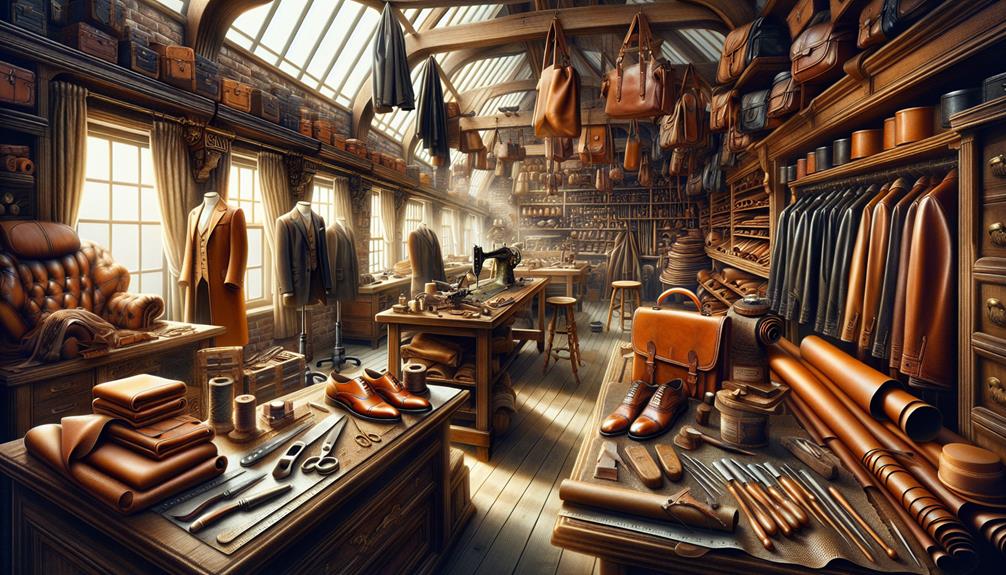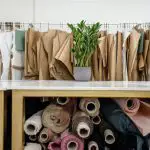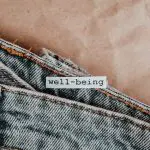I use leather because it's super durable and gets even nicer with age. It's tough against wear and tear, perfect for daily use. Plus, it's breathable, which means my boots or jacket feel comfortable no matter the weather. Leather's also naturally insulating, so it keeps me warm in winter without feeling bulky. And, it looks great; leather adds a touch of class to almost anything, from bags to sofas, developing a unique patina that makes each piece special. Another big plus? It's sustainable, recycling materials that would otherwise go to waste. There's a lot more to why I stick with leather.
Table of Contents
Key Takeaways
- Leather is highly durable, resistant to abrasion, and develops a unique patina, making it a long-lasting material.
- It offers excellent breathability, allowing for air flow and moisture regulation, enhancing comfort and durability.
- Leather's insulating properties make it ideal for retaining warmth, useful in cold climates and for winter apparel.
- The material can be customized and molded into various forms, making it versatile for fashion and functional uses.
- Leather is a sustainable choice, recycling millions of cow hides annually, reducing waste and promoting environmental responsibility.
The Durability of Leather
One of the biggest perks of leather is its impressive durability. When I'm choosing materials for products that I need to last, leather is my go-to. It's not just tough; it's abrasion resistant. This means it can handle a lot of rough treatment without showing much wear. I've had leather goods that have lasted years and still look great.
Leather's long-lasting quality isn't just about surviving scrapes and bumps. It's also about how it ages. Unlike many materials that deteriorate and look worn out, leather develops a patina. This isn't just a fancy term for looking old; it's about evolving a distinctive character that makes each leather item unique. The more I use it, the better it looks and feels.
Investing in quality leather products really pays off in the long run. It aligns perfectly with the idea of 'buy less, buy better'. Instead of buying cheap items that I'll have to replace often, I choose durable, quality leather goods that stand the test of time. It's not just a purchase; it's an investment in something that grows in value and appeal.
Leather's Breathability Features
Besides its durability, leather's breathability also makes it a standout choice for everyday wear. Now, let's break down why that's the case. When you slip into a leather jacket or pair of shoes, you're not just looking stylish; you're also signing up for some top-notch comfort, thanks to how well leather handles air and moisture. This material isn't just sitting on your skin; it's working hard to make sure you stay comfy.
Leather's natural fibers play a huge role in this. They allow air to flow and moisture to pass through, which means you're not trapped in a sweatbox. This airflow helps keep the temperature just right, so whether it's a bit chilly or warm outside, you're sorted. Plus, it prevents that icky feeling of sweat buildup which, trust me, nobody wants.
And here's the kicker: all this moisture regulation and temperature control contribute to the leather's durability. It's not just about staying dry; it's about your leather gear lasting longer because it's not breaking down from moisture or getting all stretched out. So, you see, leather's breathability is a big deal—it keeps you comfortable and your leather looking sharp for years.
Insulating Properties of Leather
Leather's natural insulation keeps you toasty when temperatures drop. Let me explain why it's such an ideal material for colder climates. Basically, leather is an insulator material. This means it's really good at retaining heat, which is exactly what you want when it's chilly outside.
The insulating properties of leather are pretty remarkable. It helps regulate body temperature by trapping heat right next to your skin. You know how sometimes you feel just right, not too hot or too cold? That's leather working its magic. It's not just about staying warm, though. It's about maintaining a comfortable balance, and that's what makes leather stand out.
Think about your favorite winter jacket or those comfy gloves. Chances are, they're made of leather, and there's a good reason for that. This material doesn't just keep you warm by chance; it's designed to do so. Whether it's a brisk morning walk or a freezing night out, leather has got your back.
Water Resistance in Leather
While leather keeps us warm, it also offers varying degrees of water resistance, which is just as important for staying comfortable. You see, not all leather is created equal when it comes to dealing with water. Some are just water-resistant, meaning they can fend off a bit of moisture but aren't completely waterproof. This quality is crucial, especially when you're talking about outdoor shoes that face all kinds of wet conditions.
Most of the really tough, waterproof leather comes from cattle hides. These hides provide exceptional durability. That's why they're often chosen for making items that need to stand up to harsh weather—like your favorite hiking boots. The natural strength and resilience of cattle hide leather make it a top pick for anything that needs to last through rain, mud, and more.
Now, to boost this natural water resistance, waterproofing treatments are applied. These treatments help prevent water from soaking into the leather, keeping your feet dry and your shoes in good shape. They're essential for maintaining the quality of the leather, so it doesn't just resist water but continues to offer flexibility and maintain its form even when it gets wet. This makes treated leather ideal for all sorts of outdoor gear.
Molding and Reshaping Leather
One of the coolest things about leather is how you can mold and reshape it into just about any form you need. This unique property not only makes leather incredibly versatile but also allows for extensive customization. Whether you're crafting a bespoke pair of boots, a tailored jacket, or a custom wallet, the ability to manipulate leather is key.
Here's a quick look at what makes molding and reshaping leather so special:
- Versatility in Applications: From fashion to functional items, leather's adaptable nature means it can be used for just about anything.
- Customization Opportunities: This material welcomes all sorts of personal touches, making each leather piece distinct.
- Durability and Longevity: After being molded, leather retains its shape and strength, ensuring that products last for years.
Leather as a Sustainable Choice
Every year, over 270 million cow hides are recycled, making leather a surprisingly sustainable choice. I mean, think about it: that's a massive amount of material that's not just tossed into landfills. Instead, these animal hides are transformed into durable, useful leather products. This not only helps reduce waste but also taps into the ethos of recycling and responsible consumption.
Leather's journey from being a simple by-product to becoming a cornerstone of sustainable fashion is pretty incredible. By using hides that would otherwise contribute to environmental degradation, the leather industry supports a broader societal shift towards sustainability. It's about making the most of resources we already have, which is a smart move in our book.
Moreover, the qualities of leather itself speak volumes about sustainability. Its durability means that leather products can last for years, if not decades. This longevity reduces the need for frequent replacements, cutting down on consumer waste. Being part of this cycle feels good, knowing I'm opting for a material that holds up over time and keeps its promise on sustainability. Plus, it's a choice that respects the planet by minimizing waste, which is a win in any scenario.
The Aesthetic Appeal of Leather
Beyond its sustainability, I'm also drawn to leather for its stunning looks and luxurious feel. The aesthetic appeal of leather isn't just about its visual impact; it's the whole vibe it brings to the table. When you see a leather piece, whether it's a jacket, a sofa, or a wallet, you instantly feel its premium quality and craftsmanship. Its luxurious appearance makes it a standout choice for anyone aiming to elevate their style or their surroundings.
Leather's beauty isn't static either. One of the coolest things about it's the unique patina it develops over time. This isn't something you get with many materials. As leather ages, it gains character and tells a story, enhancing its aesthetic appeal even more.
To really paint a picture of why I'm all about this material, consider these aspects:
- Timeless elegance: It never goes out of style, making any leather item a long-term investment.
- Fine grain patterns: Each piece has its own distinct texture, adding to its unique allure.
- Rich and varied finishes: From smooth and glossy to rugged and matte, there's a look for every taste.
Each of these elements contributes to why leather is more than just a material; it's a statement.
Versatile Uses of Leather
Leather's versatility shines in its myriad uses, from stylish clothing to durable furniture and beyond. When I think about why we use leather, it's got to be because of how adaptable this material is. You can find it everywhere – in the shoes on your feet, the sofa in your living room, and even the wallet in your pocket. What makes leather so widely used? It's all about the characteristics of leather; it's tough, it breathes well, and it can take a beating and still look great.
Different types of leather mean it's not just versatile in use, but also in style and function. The same material made to insulate your feet in rugged boots is also crafted into elegant, soft gloves or luxurious car seats. Modern technology has just upped the game, enhancing leather's feel and aesthetics, making it a top choice for not just personal items but also in commercial spaces and fancy vehicles.
It's clear to see why leather is a go-to material. Its durability, functionality, and timeless style make it a smart pick for so many different applications. Whether it's for everyday use or luxury, leather really does cover it all.
Maintenance and Repair of Leather
When it comes to keeping your leather in top shape, knowing how to clean it properly is key.
You'll also want to use the right conditioners to ensure it stays supple and lasts a long time.
Plus, fixing common issues like scratches or scuffs at home can be simpler than you might think.
Cleaning Leather Properly
To keep your leather in top shape, start by regularly wiping it down with a damp cloth to remove any dirt and dust. Quality leather, especially top grain leather, is easy to maintain if you treat it right. Here's how I keep my leather goods looking great:
- Mild Soap Solution: For a deeper clean, I use a gentle soap mixed with water. It's effective without being harsh on the hides.
- Soft Cloth: Always use a soft cloth to apply any cleaning solution; it helps avoid scratches.
- Air Dry: After cleaning, I let my leather items air dry naturally, away from direct heat or sunlight.
This simple routine helps my leather stay in excellent condition.
Conditioners for Leather Longevity
After cleaning, I always apply a leather conditioner to keep my items soft and prevent damage. Using leather conditioners is key; they're like a spa treatment for your leather goods! They help by moisturizing the material, which prevents it from drying out and cracking. This not only makes your leather items last longer but also keeps them looking supple and shiny.
Here's a quick table on how often and why I use conditioners:
| Frequency | Reason |
|---|---|
| Monthly | Moisturizing and protecting |
| As needed | After exposure to elements |
| Seasonally | Prepare for weather changes |
| When dull | Restore shine and suppleness |
| Before storage | Protect while not in use |
Regular conditioning truly is the secret to longevity and beauty in leather care.
Fixing Common Leather Issues
Fixing common leather issues is easier than you might think, requiring only simple tools and some know-how. Whether you're dealing with natural leather or another type of leather, the principles are pretty much the same.
Here's how I handle leather repairs:
- Identify the Damage: Assess whether it's a scratch, tear, or discoloration.
- Clean the Area: Always start with a clean surface before any repair.
- Apply the Right Treatment: Use a leather repair kit suited for the specific damage and leather type.
Repairing leather items not only extends their life but also supports sustainable practices by reducing waste. Remember, investing in quality like leather is the best way to ensure durability and timeless style.
Frequently Asked Questions
Why Do Humans Use Leather?
I use leather because it's durable, ages well, and is versatile for many items like jackets and boots. It's also breathable and water-resistant, making it practical for both fashion and function.
What Was Leather Originally Used For?
Leather was initially used for clothing and protection by ancient civilizations. It's been vital for its durability, becoming essential for items like footwear, saddles, and even furniture upholstery through the ages.
What Is the Most Important Use of Leather?
The most important use of leather is in fashion, particularly for making durable, breathable, and stylish items like shoes, jackets, and accessories. It's valued for its longevity and luxury appeal.
Why Is Leather Used so Much?
Leather's extensively used because it's durable, versatile, and stylish. It's perfect for various products like shoes and jackets, offering long-lasting quality that many other materials just can't match.
- How Does Ring Spun Cotton Affect Garment Fit and Shape Retention? - August 13, 2024
- What Are the Challenges in Producing Ring Spun Cotton? - August 13, 2024
- Is Ring Spun Cotton Suitable for Plus-Size Clothing? - August 13, 2024







